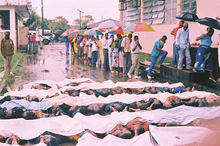1998 Monrovia clashes
| Monrovia clashes | |||||||
|---|---|---|---|---|---|---|---|
| Part of the aftermath of the First Liberian Civil War | |||||||
 The bodies of Krahn civilians that were massacred by government forces during or after the clashes in Monrovia. |
|||||||
|
|||||||
| Belligerents | |||||||
|
|
Limited involvement: |
||||||
| Commanders and leaders | |||||||
|
|
|
||||||
| Units involved | |||||||
|
|
||||||
| Strength | |||||||
| Hundreds | Johnson's forces: Hundreds | ||||||
| Casualties and losses | |||||||
| Unknown, several killed |
|
||||||
| Dozens of civilians killed during the clashes, hundreds massacred afterwards | |||||||
Partial victory of Charles Taylor
The Monrovia clashes in 1998 were the result of Liberian President Charles Taylor's attempts to violently eliminate one of his last domestic political opponents, Roosevelt Johnson, a former warlord of Krahn ethnicity. At the time, Johnson still lived with a small loyal militia in Monrovia, the capital of Liberia. After some minor armed altercations, almost all of Johnson's followers were finally killed by Taylor's security forces during a major firefight in September 1998, though Johnson himself managed to flee into the United States embassy. After one last attempt by Taylor's paramilitaries to kill him there, causing a major diplomatic incident, Johnson was evacuated to Ghana. Although the clashes were effectively a political victory for Taylor as he had removed Johnson from Liberia, the mass killings of ethnic Krahn after the clashes contributed to the outbreak of the Second Liberian Civil War which saw the president being toppled.
After being elected in 1997, President Charles Taylor had fortified his power over Liberia, mostly by purging the security forces of opponents, killing opposition figures, and raising new paramilitary units that were loyal only to him or his most trusted officers. Nevertheless, he still faced a few remaining opponents in the country, mostly former warlords of the First Liberian Civil War who had kept part of their forces to protect themselves from Taylor. His most important domestic rival by early 1998 was Roosevelt Johnson, a Krahn leader and former commander of the ULIMO. Although Taylor had appointed him rural development minister, Johnson remained a threat because he still had hundreds of armed followers who remained in Monrovia. Protected by Nigerian ECOMOG peacekeepers, Johnson, his men and their families (mostly ethnic Krahn) lived in a fortified one-block-long apartment compound in the capital's downtown which was nicknamed "Camp Johnson Road".
...
Wikipedia
